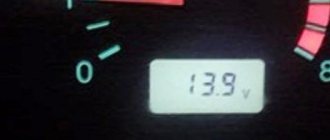In a car, the car's alternator is responsible for charging the battery. In fact, it is a device that is driven by a motor and converts mechanical energy into electrical energy. In turn, the car battery, spending part of its charge to start the engine and maintain power in the on-board network when the engine is turned off, needs active recharging.
If the system is working properly, the battery is recharged from the generator, and there is no undercharging or overcharging of the battery. However, during the operation of the car, problems may arise for a number of reasons. The result is that the battery fails. In this case, the “health” of the battery deteriorates in all cases (if the battery is very discharged, there is a constant discharge, if it is overcharged, the battery boils).
One way or another, in such a situation a diagnosis is necessary. Next, we will look at how much a car’s generator produces normally, why the generator does not charge the battery, for what reasons overcharging occurs, what voltage should be on the battery, etc.
Important points
The voltage (U) and capacity of the car battery are the main parameters that need to be paid attention to when choosing and checking a power source.
The main purpose of the battery is to start the engine during the period when the car's generator has not yet been connected to work, and the battery is the only power source.
To eliminate operational problems, the car owner should know the following points:
- What does the battery life depend on?
- What should the voltage be (in normal mode, after starting the engine and under load);
- What causes the decrease in capacity during the cold season and other issues.
Let's consider these questions in detail.
Content
Car generator
- a device that converts the mechanical energy of rotation of the crankshaft of a car engine into electrical energy.
A car generator is used to power electrical consumers, such as the ignition system, car lighting, on-board computer, diagnostic system and others, as well as to charge a car battery [1]. Car generators are subject to high reliability requirements, since the generator ensures uninterrupted operation of most components of a modern car. The typical power of a modern generator in a passenger car is about 1 kW.
What determines the shelf life of a battery?
Each manufacturer, after manufacturing a battery, sets a warranty period for its operation.
In addition to this parameter, there is an actual period that depends on many factors - timeliness of maintenance, compliance with operating rules, condition of electrical wiring and other points.
Due to the fact that battery maintenance conditions differ, the shelf life of the product also differs.
Car owners who use their car only in the warm season have the longest battery life. It's another matter when you need a car all year round, regardless of the outside temperature.
In such a situation, the battery life is reduced. This is also due to the fact that in the second case the driver can cover more kilometers.
The battery life is also affected by:
- Serviceability and correct operation of the generator and voltage regulator.
- Connecting additional equipment with a large rated current to the vehicle's electrical wiring.
- Operating mode. The batteries that last the least are those in taxis that travel a long distance throughout the year. In addition, such cars operate in frequent engine starting mode, which puts a load on the battery and generator. If the vehicle is actively used, the service life of the power source does not exceed 1.5 years.
Under normal operating conditions, when the car owner regularly checks the battery and carries out maintenance, the battery life is 4-5 years with a total mileage of 60-80 thousand kilometers during this period.
To avoid problems, it is advisable to periodically check the voltage of the generator and battery.
But the mentioned service life is not the highest, because with careful maintenance the battery can last up to eight years.
But you should know that sooner or later the battery will need to be replaced, because from the moment you start using it, the working plates gradually wear out. The more charge and discharge cycles a battery goes through, the faster it breaks down.
Practice shows that the key role is played by the generator, its serviceability and current voltage. That is why this aspect needs to be given key attention.
Preparing for work
There is always a possibility of finding yourself in a situation where it is not possible to get to a service station and seek help from specialists. And if so, then every self-respecting car owner should know how to check how much the generator produces with a multimeter. This will avoid many unnecessary problems and save a lot of time and money. And, what is especially important, this does not require either complex equipment or specific skills.
A multimeter is usually called an electrical measuring device that combines several functions. This device can be purchased at an affordable price at most hardware stores. In DC and AC networks, it allows you to measure:
- Voltages.
- Power.
- Resistance.
A box with a mode switch and an analog or digital display scale will be useful not only when repairing a car, but also in the household. Therefore, it is always advisable to have it in your arsenal of tools.
What generator voltage is considered normal?
To check the generator voltage, you need to start the engine and turn off the entire load. In this case, the multimeter should show 14.3 -15.5 Volts (see video at the end of the article). A deviation of 0.1 Volt in one direction or the other is allowed.
After this, it is necessary to connect consumers one by one and check the generator voltage.
Ideally, it should “drop” by about 0.2 Volts when you turn on each new load. In this case, the total U should not fall below the level of 12.8 Volts. Otherwise, the battery will be discharged.
What is more profitable - repairing or buying a new generator?
This is a pressing question, and it is asked by many who have had a generator break down. Let's answer it simply and logically: everything will depend on the breakdown. There are a lot of things that can be fixed in a generator for very little cost. Replacement of all kinds of bearings, pulleys, diodes, rotor rings and so on. Even in a workshop, the price order will pleasantly surprise you, here is an example of a random Moscow workshop:
A new original generator, even for a budget foreign car, can cost several tens of thousands of rubles. A substitute (non-original) is cheaper, but still 10-15 thousand rubles . This can be seen in the example of the far from new Ford Focus II:
Such a purchase can hardly be called logical if the car is old or a minor breakdown has occurred, which will cost a maximum of 2-3 thousand rubles .
But if the generator is old and it will have to rewind the stator/rotor of the generator, then you will begin to think about whether this complex and time-consuming process is advisable or is it better to buy a new generator? After all, the average cost of rewinding can reach up to half the cost of a new unit, and in some cases even more (not all companies provide a guarantee, and those that do provide it are no more than 12 months). In this case, it is better to buy a generator at a disassembly site. It is also a “pig in a poke”, but cheaper.
Cover: 1GAI.ru
Minimum battery input voltage parameter
When checking the parameters of the generator, it is worth taking into account the characteristics of the battery itself.
Many car owners are interested in what the voltage at the battery output should be for normal engine starting.
There is no exact answer here, but the average parameter should be 12.6-12.7 V. Depending on operating conditions, this indicator can be adjusted.
Some manufacturers claim that their product has a voltage of 13-13.2 Volts. This parameter is real, but you should not measure the voltage immediately after recharging with a generator or charger.
It is advisable to wait 1-2 hours before carrying out work. In this case, U should drop to a level of 12.7-13 V.
If this parameter begins to “float” or drops below 12 V, this indicates a 50% battery discharge or a generator malfunction.
It is recommended to check the charging circuit or use an external charger.
If you continue to operate the battery in this condition, sulfation of the lead plates occurs, which reduces the performance of the battery and reduces its service life.
In practice, such a decrease in voltage is not critical, because the battery can still be started, and then the generator recharges to the required level.
The main thing is to make sure that the charging circuit is working properly and that the voltage at the battery terminals is increasing.
If U at the output drops below 11.6 V, we can talk about the complete discharge of the power source.
In this case, further use of the battery is impossible - it must be removed, checked for serviceability, and charged from an external device.
Taking into account the above, we can conclude that the voltage on the battery with a working generator should be (with the engine off) 12.6-13.2 V. In practice, this parameter is slightly lower and amounts to 12.3-12.5 V.
This voltage indicates a slight undercharging of the battery. There's nothing wrong with that. The main thing is not to allow U to decrease below 12 V.
Generator voltage at idle
To check the functionality of the generator, you need to start the engine and measure the voltage at the battery terminals. Normal U is 13.5-14 V.
If this parameter increases above 14.2 V, we can conclude that the battery charge is decreasing and the generator is switching to an enhanced charging mode.
This situation occurs in rare cases when the battery is discharged due to prolonged standstill in the cold or a connected load.
Situations are possible when the car’s electronics do not allow the generator voltage to increase, based on the ambient temperature.
The increase in U level, which is supplied to the battery from the generator, is not critical. If the electrical equipment of the machine is working properly, after 5-10 minutes the charge voltage will drop to the required level of 13.5-14.0 Volts.
If U does not decrease, it is necessary to begin repairing the power circuit or generator. Otherwise, it will end with boiled-off electrolyte.
If, when the engine is running at XX, the generator produces a voltage of 13.0-13.4 V, this indicates problems with the battery (the latter does not take part of the charge).
In such a situation, it is worth checking the generator when all consumers are turned on - headlights, music, air conditioning and others. We'll talk about this below.
Why can't modern generators have enough power?
photo: cardekho.com
As we said above, modern cars have three-phase generators. Gone are the days (around the late 70s - early 80s) when unproductive generators produced little power, depending heavily on engine speed. This could be observed on old motorcycles and scooters: when the engine is idling, the headlights glow dimly. As soon as you turn the throttle, the light will light up brightly.
Now, even at idle (from 650 to 900 crankshaft revolutions per minute), modern generators generate sufficient power and, therefore, produce the required volumes of electricity to supply all consumers in the car.
Generator voltage under load
To ensure the functionality of the power supply, it is recommended to perform a load test.
To begin with, remember that there are three types of voltage:
- Nominal - indicated in the operating instructions. It is 12 Volts. This figure is far from the actual U value.
- Actual . Here we are talking about the voltage parameter after installing, connecting and starting to use the car battery. On average, this parameter is 12.6-13.2 V (this was mentioned above).
- Under load . Here the voltage parameter supplied by the generator can change.
The presence of a load allows you to verify the health of the battery and generator.
A seemingly serviceable battery with an output of 12 V can drop significantly after switching on the consumers. During the testing process, an additional device is used - a load fork, which allows for an increased load on the battery.
Let's give an example.
If your battery capacity is 60 mAh, the load value should be 120 A. The connection duration is 3-5 seconds.
We can say that the power supply is working properly if the voltage does not drop below 9 Volts. If the parameter drops to 5-6 V, this indicates a complete discharge of the battery. After testing under load, the voltage should return to 12.2-12.4 V.
If a strong drawdown is detected, it is necessary to check the battery, and then repeat the experiment with the plug again. If there is no drawdown, we can talk about the health of the battery.
To check the generator, you can do the following: start the car, turn on as many consumers as possible, and then take a measurement. The voltage should be 13.5-14 V.
If it is lower, this indicates a failure of the generator. The lower critical limit is 13.0 V.
If the voltage of the car's generator is very low, do not rush to draw conclusions - make sure that the contacts on the battery are not oxidized. If so, rub them with sandpaper.
Electrical diagram
Manufacturers take into account the specific number of consumers in a car model, so in each case an individual electrical circuit of the generator is used. The most popular are 8 diagrams of “mobile electrical installations” under the hood of a car with the same designation of elements:
- generator block;
- rotor winding;
- stator magnetic circuit;
- diode bridge;
- switch;
- lamp relay;
- regulator relay;
- lamp;
- capacitor;
- transformer and rectifier unit;
- battery;
- Zener diode;
- resistance.
Rice. 15 Scheme 1
In schemes 1 and 2, the exciting winding receives voltage through the ignition switch so that the battery does not discharge when parked. The disadvantage is the switching of 5 A current, which reduces the service life.
Rice. 16 Scheme 2
Therefore, in diagram 3, the contacts are unloaded by the intermediate relay, and the current consumption is reduced to tenths of an ampere. The disadvantage of this option is the complex installation of the generator, decreased reliability of the design, and the switching frequency of the transistor increases. The headlights may blink and the instrument needles may shake.
Rice. 17 Scheme 3
In circuit 5, an additional rectifier is made from three diodes on the way to the excitation winding. However, when parking for a long time, it is recommended to remove the “+” from the battery terminal, as the battery may be discharged. But during the initial excitation of the winding at the moment of starting the internal combustion engine, the battery current consumption is minimal. Extinguish the zener diode, which is dangerous for the electronics of the machine.
Rice. 18 Scheme 5
For diesel engines, generators using circuit 6 are used. They are designed for a voltage of 28 V; the exciting winding receives half the charge due to connection to the “zero” point of the stator.
Fig 19 Scheme 6
In diagram 7, the discharge of the battery during long-term parking is eliminated by reducing the potential difference at the “D” and “+” terminals. An additional wing of the rectifier diode bridge was created from zener diodes to eliminate voltage surges.
Rice. 20 Scheme 7
Scheme 8 is usually used in Bosch generators. Here the voltage regulator is complicated, but the circuit of the generator itself is simplified.
Rice. 21 Scheme 8
Voltage on the generator for charging the battery
It is no secret that when charging a battery using a stationary charger, the input voltage should be in the range of 13.5-14.5V.
At the same time, it is necessary to monitor the voltage level at the battery terminals. As soon as U stops growing, we can talk about a full charge. If you continue the process, the electrolyte may “boil”.
After starting the engine, the charging current is at the level of 5-10 Amperes (sometimes more), but after a few minutes it drops to 1-3 A, which is considered the optimal parameter for the battery.
An indirect indicator of the normal operation of the generator is the voltage at the terminals a few minutes after starting the engine. This indicator should be at the level of 13.9-14.2 V.
Its value largely depends on the climatic conditions in which the vehicle is operated.
Analysis of the received data
Don't try to draw premature conclusions. The fault can only be determined after receiving all the necessary data. As mentioned above, several options are possible.
Low charging current
You should start with the simplest thing, making sure that the generator drive belt is properly tensioned and there is no damage to the electrical wiring contacts. If this is all right, then the sources of the problem may be:
- Faulty charging current relay. The most common and easily fixed breakdown. The part costs a penny, and you can replace it yourself if you have basic equipment repair skills.
- Breakdown in the stator or rotor winding. Fixing such a breakdown requires a lot of time and money. It is possible that it is easier to replace the generator with a working one.
Failure of the windings is quite rare, so it is advisable to first replace the relay.
High charging current
In this case, tightening the belt and cleaning the contacts is not enough. Among the likely culprits of the misfortune:
- Charging current relay. You need to install the correct one.
- A diode bridge that performs the tasks of a rectifier.
The diode bridge can only be replaced by specialists in an equipped workshop.
Power surges
You probably already guessed that when detecting power surges, you will have to choose from several options, the most likely of which are:
- Drive belt slippage. It occurs when the tension is weakened or lubricants enter the working surfaces.
- Malfunction of the diode bridge, due to which it becomes impossible to stabilize the current.
- Poor contact between brushes and slip rings.
Brushes have a limited lifespan and wear is normal. These parts must be changed periodically, since if they collapse, they damage the slip rings. It may be impossible to repair such a breakdown.
A few words about electrolyte
One of the main indicators by which you can judge the health of a battery is the electrolyte level. The voltage of the power supply depends on it under different operating modes.
In the process of discharging the battery, acid is consumed, the share of which in the total volume of liquid is a third (35-36%).
The result is a decrease in the density of the liquid. When the battery is charged, the reverse process occurs.
In such a situation, water is consumed, and acid, on the contrary, is formed. As a result, the density of the electrolyte increases.
In the normal state, when the battery voltage is 12.7 V, the density is 1.27 g/cc. Moreover, all parameters directly depend on each other.











